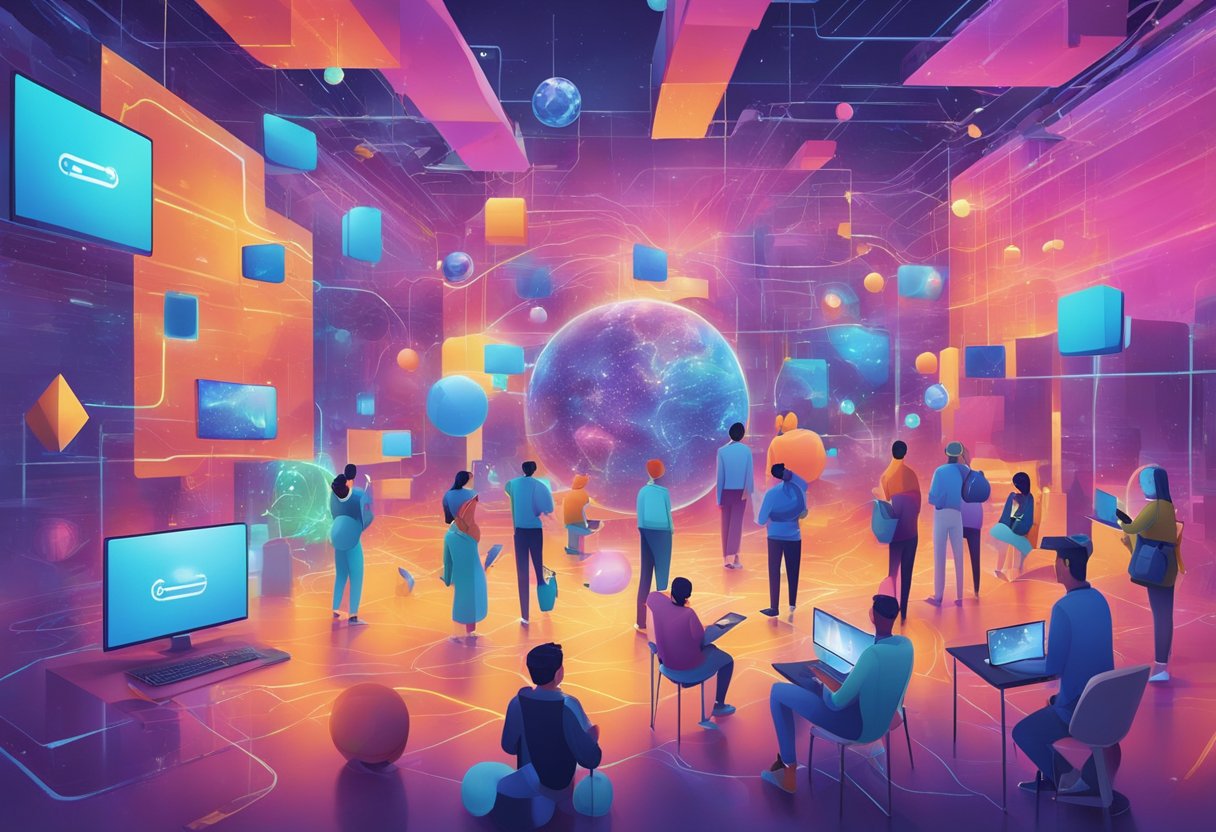The concept of the metaverse has been gaining traction in recent years as technology continues to advance. The metaverse is a virtual world that is created by the convergence of multiple virtual environments. It is a place where people can interact with each other and experience a wide range of activities, from gaming to socializing to commerce.
The metaverse is built on a foundation of advanced technologies such as virtual reality, augmented reality, and blockchain. These technologies allow for the creation of immersive and interactive virtual environments that can be accessed from anywhere in the world. The metaverse has the potential to revolutionize the way we interact with technology and with each other, creating new economic and social opportunities.
Key Takeaways
- The metaverse is a virtual world that is created by the convergence of multiple virtual environments.
- The metaverse is built on a foundation of advanced technologies such as virtual reality, augmented reality, and blockchain.
- The metaverse has the potential to revolutionize the way we interact with technology and with each other, creating new economic and social opportunities.
Defining the Metaverse
Conceptual Origins
The concept of the metaverse was first introduced in Neal Stephenson’s science fiction novel Snow Crash, which depicted a virtual reality world where people could interact with each other and the environment in a fully immersive way.
The idea was further popularized by the novel Ready Player One, which depicted a dystopian future where people spent most of their time in a virtual world called the OASIS.
The metaverse is essentially a virtual world that is fully immersive and interactive, allowing people to engage with each other and the environment in a way that is not possible in the physical world.
Modern Interpretations
Today, the metaverse is often used to refer to a range of virtual reality technologies, including virtual worlds, augmented reality, and video games. It is seen as the next evolution of the internet, where people will be able to interact with each other and the environment in a fully immersive and interactive way.
The metaverse is expected to have a range of applications, from entertainment and socializing to education and business. It is still in the early stages of development, but many companies are investing heavily in the technology, and it is expected to become a major part of our lives in the coming years.
Technological Foundations

The metaverse is built on a foundation of hardware and software technologies that enable the creation of immersive virtual worlds. This section explores the three primary technological building blocks that underpin the metaverse.
Hardware and Devices
The hardware and devices used to access the metaverse are critical to the user experience. Virtual reality (VR) headsets like Oculus and augmented reality (AR) devices are the primary tools used to immerse users in the metaverse.
These devices are equipped with sensors and cameras that track user movements and enable them to interact with the virtual environment.
Software Platforms
The metaverse is powered by software platforms like Unity that enable developers to create immersive virtual worlds. These platforms provide a range of tools and resources that allow developers to create interactive experiences that can be accessed by users across a range of devices.
Networking and Interoperability
Networking and interoperability are critical components of the metaverse. The metaverse is built on a foundation of cloud computing and blockchain technology that enables users to access and interact with virtual worlds from anywhere in the world.
Artificial intelligence (AI) is also an essential component of the metaverse, enabling virtual environments to respond to user actions and interactions in real-time.
The technological foundations of the metaverse are complex and multifaceted, requiring a range of hardware, software, and networking technologies to create immersive virtual worlds that can be accessed and interacted with by users across the globe.
Economic and Social Impact

Digital Economy
The Metaverse is poised to have a significant impact on the global digital economy. With the rise of cryptocurrencies and NFTs, the Metaverse is creating new marketplaces, new types of businesses, and new employment opportunities.
Creators are at the forefront of bringing this future closer. The Metaverse continues to hold significant promise for driving creativity and economic opportunity around the world.
Social and Cultural Influence
The Metaverse has the potential to significantly influence social and cultural norms. As people spend more time in virtual worlds, they may begin to adopt new social norms and behaviors.
The Metaverse can also create new opportunities for social media, marketing, and entertainment. However, there are also concerns about how the Metaverse may exacerbate existing social inequalities.
Legal and Privacy Considerations
As the Metaverse continues to develop, there will be significant legal and privacy considerations that need to be addressed.
Ownership of virtual real estate and other assets will need to be established, and governance structures will need to be put in place to ensure that the Metaverse is a fair and equitable space for all users. Privacy concerns will need to be addressed to ensure that users’ personal information is protected.
The Future of the Metaverse

The metaverse is a concept that has been around for a while, but it is only recently that it has started to gain traction. There are many emerging trends that are likely to shape the future of the metaverse.
Emerging Trends
One of the most significant trends is the move towards interoperability. This means that different virtual worlds will be able to interact with each other, making it possible for users to move seamlessly between different environments. This will make the metaverse more accessible and easier to use.
Another trend is the move towards greater immersion and presence. As technology continues to improve, it will become possible to create more realistic and lifelike environments. This will make the metaverse more engaging and enjoyable for users.
Challenges and Opportunities
However, there are also challenges that must be addressed. One of the biggest challenges is ensuring that the metaverse is accessible to everyone. This means making sure that it is easy to use for people with disabilities, as well as ensuring that it is available to people in different parts of the world.
Another challenge is the impact that the metaverse could have on society. It is important to ensure that the metaverse is used in a responsible way, and that it does not have a negative impact on people’s lives.
The future of the metaverse is interconnected with many different factors. By addressing the challenges and opportunities that lie ahead, it will be possible to create a metaverse that is both engaging and accessible for everyone.

Frequently Asked Questions
What are the leading platforms in the metaverse?
The leading platforms in the metaverse include Second Life, VRChat, High Fidelity, and Sansar. Second Life, launched in 2003, is one of the oldest and most popular virtual worlds. VRChat, launched in 2017, is a social VR platform that allows users to create and share their own virtual worlds.
High Fidelity, launched in 2016, is a platform that focuses on creating realistic virtual environments. Sansar, launched in 2017, is a platform that allows users to create and share their own virtual reality experiences.
How is virtual reality technology integral to the metaverse experience?
Virtual reality technology is integral to the metaverse experience because it allows users to immerse themselves in virtual environments and interact with others in real-time.
Virtual reality headsets, such as the Oculus Rift and HTC Vive, provide a more immersive experience than traditional computer screens. Additionally, virtual reality technology allows users to interact with virtual objects and environments in a more natural way, using body movements and gestures.
What are some notable films that explore the concept of the metaverse?
Some notable films that explore the concept of the metaverse include The Matrix, Ready Player One, and Tron. These films depict virtual worlds that are interconnected with the physical world and explore themes such as identity, reality, and power.
In what ways can individuals and companies participate in the metaverse economy?
Individuals and companies can participate in the metaverse economy by creating and selling virtual goods and services, such as virtual real estate, clothing, and entertainment.
Companies can also create virtual experiences for marketing and advertising purposes. Individuals and companies can invest in virtual currencies, such as Bitcoin and Ethereum, which are used as a form of payment in some virtual worlds.
How do privacy and ownership function within the metaverse?
Privacy and ownership function within the metaverse through the use of blockchain technology, which allows for secure and transparent transactions.
Users can own and control their virtual assets, such as virtual real estate and digital art, through the use of non-fungible tokens (NFTs). Privacy can be maintained through the use of pseudonyms and encrypted communication channels.
What potential applications does the metaverse have beyond gaming?
The metaverse has potential applications beyond gaming, such as in education, healthcare, and remote work. Virtual reality technology can be used to create immersive educational experiences, such as virtual field trips and language learning.
In healthcare, virtual reality can be used for pain management and therapy. Wirtual reality can be used for remote work and collaboration, allowing individuals to work together in a virtual environment regardless of their physical location.




